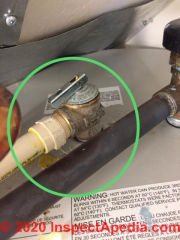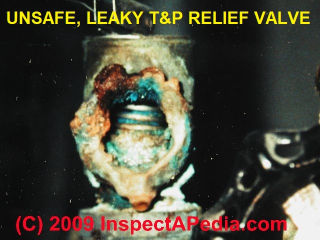 Relief Valve Leaks from Thermal Expansion
Relief Valve Leaks from Thermal Expansion
Hot water expansion TPR valve leak cause & cure
- POST a QUESTION or COMMENT about the causes & cures of leaks and discharges from pressure relief valves or TP valves
Why the relief valve leaks: thermal expansion of hot water
This article explains hot water thermal expansion that can cause leaks, drips, or discharges from pressure relief valves, temperature/pressure relief valves, or TP valves found on heating boilers, water heaters.
We explain how to find and fix leaky relief valves on hot water heating systems.
Watch out: a dripping or frequently spilling T&P valve is dangerous because those very leaks can eventually cause the valve to clog and then to fail to open when it should.
InspectAPedia tolerates no conflicts of interest. We have no relationship with advertisers, products, or services discussed at this website.
Closed Hot Water Systems & Thermal Expansion Problems - Why is the Water Heater Relief Valve Leaking?
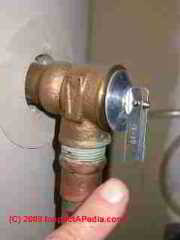 Watts and other manufacturers of TP valves warn of serious safety hazards caused by dripping at the TP discharge line and point out that often the dripping is caused by thermal expansion of hot water.
Watts and other manufacturers of TP valves warn of serious safety hazards caused by dripping at the TP discharge line and point out that often the dripping is caused by thermal expansion of hot water.
When water is heated in a closed plumbing system, it expands, causing an increase in pressure. This increase in system pressure over that regulated by the pressure reducing valve is called thermal expansion pressure. The T&P valve is a safety device and is not intended for continuous operation to relieve thermal expansion.
Continuous dripping can cause the build up of mineral deposits on the valve and may render it useless. - Watts (2011)
See HOT WATER PRESSURE EXPANSION RATE - for an explanation of just how much pressure increase to expect when heating water. In explaining why the relief valve on a water heater may be dripping, American Water Heater Co. [1] explains:
Periodic discharge of the temperature and pressure relief valve may be due to thermal expansion in a closed water supply system. The water utility supply meter may contain a check valve, backflow preventer or water pressure reducing valve. This will create a closed water system.
During the heating cycle of the water heater, the water expands causing pressure inside the water heater to increase. This may cause the temperature and pressure relief valve to discharge small quantities of hot water. To prevent this from happening, there are two recommendations:
- Install a diaphragm-type expansion tank that is suitable for potable water on the cold water supply line. The expansion tank must have a minimum capacity of 1.5 U.S. gallons for every 50 gallons of stored water.
- Install a 125 PSI pressure relief valve in the cold water supply line. Make sure the discharge of this valve is directed to an open drain and protected from freezing. [1]
Note: While a 125 psi pressure relief valve on cold water supply piping is fine to protect piping from rupturing, if building incoming water pressures are too high, rather than relying just on a relief valve (wasting water) we prefer to install a pressure reducing/control valve at the building entering water supply piping. Limit incoming water pressure to 60 psi at a typical one or two story residential home.
How to detect that a TPR valve is dripping due to thermal expansion
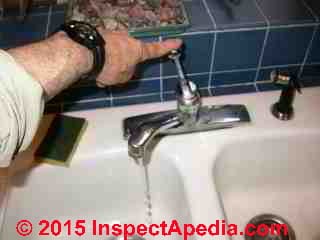 There are several reasons that a temperature/pressure relief valve or TPR valve might be dripping or leaking.
There are several reasons that a temperature/pressure relief valve or TPR valve might be dripping or leaking.
See RELIEF VALVE LEAK for a complete discussion of leaky TP valves.
Watts (2011) suggests two methods for testing for thermal expansion of hot water as the cause of a TP valve drip. The text below is adapted from that source.
- Open a water faucet and see if the dripping stops: If the TPR valve is leaking due to thermal expansion of hot water, simply opening a water faucet or fixture anywhere in the plumbing system will immediately stop the drip.
That's because opening the hot water faucet reduces the system pressure back to normal operating levels - we are no longer heating water in a "closed" piping and tank system.
Why would opening either a hot or cold water faucet work? Because when no water is running, the entire plumbing system is "closed" - unless there is an expansion tank already installed on the hot water heating system to accommodate thermal expansion, heating water in the water cylinder (water heater for Yanks) causes an increase in system pressure. - Monitor actual water piping system pressure using an temporarily or permanently-installed pressure gauge:
Install a pressure gauge on a convenient hose bib such as at the washing machine hook-up or if weather permits, outdoors. Install & use the pressure gauge to monitor system water pressure over at least a full 24-hour period. You don't have to sleep by it. If you select a pressure gauge with a re-settable "telltale" needle, the gauge's re-settable indicator will indicate the highest pressure that has been reached by the water system since the water pressure test gauge was installed.
See MEASURE WATER SYSTEM PRESSURE & PRESSURE MAXIMUM for tips on how to make or buy an inexpensive recording-type water pressure test gauge for this purpose.
Solutions for Dripping TPR Valves due to thermal expansion of hot water are given
at HOT WATER EXPANSION TANKS where we describe both hot water expansion tanks and hot water expansion relief valves designed to handle thermal water pressure increases and thus to stop dripping TP valves.
Watch out: get advice from a licensed plumber and your local water supplier. Never remove or plug a leaky pressure/temperature relief valve on a water heater - doing so risks dangerous or even fatal
BLEVE EXPLOSIONS.
See RELIEF VALVE LEAK DUE TO EXPANSION TANK where in a series of steps a homeowner figures out that a leaky TPR valve is due to the failure of the internal bladder of an expansion tank attached to the boiler.
Also see the FAQs below where we discuss closed plumbing systems caused by check valves on the cold water line.
If the building water pressure gauge reading is ever found at 80 psi or higher, you will want to install a water pressure regulator at the point where water supply enters the building.
If your building already has a water pressure gauge installed, it may be defective or it may be set too high. The articles listed just below discuss how to adjust a water pressure regulator:
- WATER PRESSURE REDUCER / REGULATOR
- WATER PRESSURE REDUCER / REGULATOR FAQs
- WATER PRESSURE VARIATION CAUSES
- WATER PRESSURE REGULATOR ADJUSTMENT
Cures for Water Heater Relief Valve Leaks due to Thermal Expansion: Expansion tanks to relieve high water pressure
An alternative to installing or changing a water pressure regulator when building water pressure is occasionally 80 psi or higher is the installation of an expansion tank to temporarily absorb that pressure increase.
Proper use of an expansion tank can help avoid unnecessary opening of the pressure/temperature relief valve on a hot water heating tank or a hot water heating boiler.
Reader Comment: why is a water heater expansion tank ever necessary?
2017/01/08 GaryC said:
You go through alot of effort to explain how heated water expands and the resulting increase in pressure. All that is well and good for theory. In a domestic (North American) water supply system, to the best of my knowlege there is nothing to prevent the expanding water/pressure from the hot water heater from just backing up into the supply plumbing and hence the water pressure in the hot water heater would NEVER exceed the supply pressure. Or is there a required one way valve somewhere in the system I am not aware of say in the hot water heater?
This comment was posted originally at RELIEF VALVE, WATER HEATER
Reply:
Good question, Gary. Thanks.
Domestic water systems in most cities are required to have a backflow preventer or check valve on the system. So when no water is being run the system is in effect closed.
My original interest and intent was to show that the actual expansion in volume from heating water is actually very small. Nevertheless, on some systems, the water heater can cause enough of a pressure increase that some installations include a small water heater expansion tank.
Even where a backflow preventer is not installed, the pressure/reducer valve at the municipal supply acts as a check valve.
And on a water system on a private well, the system pressure encounters a check valve at the water pump or a foot valve in the well.
Where expanding hot water pressure is causing trouble the common solution is the installation of a small expansion tank, usually on the hot water supply line above the water heater, though it could go almost anywhere so long as it's not isolated from the heater by a shutoff valve.
Amtrol's Therm-X-Trol expansion tank is sold specifically for this application. Here is what Amtrol says about that product:
Thermal expansion occurs as domestic water is heated. Left unchecked, the resulting pressure increase can cause relief valve discharge and other potentially hazardous conditions. Therm-X-Trol® expansion tanks absorb this expanded water, keeping water pressure at a safe level.
...
Water heater manufacturers and plumbing codes require the installation of an expansion control device if a backflow preventor, pressure reducing valve or check valve is installed in the domestic supply line.
Watch out: a leaky relief valve on a water heater, heating boiler, or any other closed vessel is dangerous. Leaks ultimately can lead to relief valve clogging, failure, and worse, BLEVE EXPLOSIONS. Beginning at RELIEF VALVE LEAKS we describe all of the causes of and cures for leaky relief valves or TP valves.
Standards & Referencs on Hot Water Expansion Requirement for Expansion Tanks or Control Valves on Water Heater Systems
- ANSI BS 7074-1:1989, Application, selection and installation of expansion vessels and ancillary equipment for sealed water systems. Code of practice for domestic heating and hot water supply (British Standard) RHE/7[91.140.10]
- IAPMO IGC 128-2008, Water heater supply shutoff valves with a thermal expansion control valves, at ansi.org. Excerpt:
This standard covers the test methods and performance requirements applicable for waterheater supply shutoff valve with a thermal expansion control valves for use on closed plumbing systems. - SS-EN 1491:2000,
Building valves - Expansion valves - Tests and requirements (Swedish Standard), at ansi.org. Excerpt:
This European Standard specifies, dimensions, materials and performance requirements (including methods of test) for expansion valves, of nominal sizes from DN 15 to DN 40, having working pressures 1) from 0,1 MPa (l bar) to 1,0 MPa (10 bar).Expansion valves are intended for fitting to the cold water supply of storage water heaters, having a maximum distribution temperature of 95 °C, for all energy sources.
Expansion valves do not control the temperature and alone does not constitute the protection required for storage water heaters. Expansion valves limit pressure, in the water heaters to what they are fitted, that is produced by thermal expansion of the water .NOTE : The use of the device specified in this Standard does not override the need to use controls (e.g. thermostats and cut-outs) which act directly on the power sources of water heaters. - "THERM-X-TROL® Water Heater Expansion Tanks", [web page] Amtrol,1400 Division Road, West Warwick RI USA 02983, Tel: 800-426-8765, Website: www.amtrol.com, retrieved 2017/01/08, original source: http://www.amtrol.com/thermxtrol.html
- "THERMAL EXPANSION TANKS for POTABLE WATER, Installation & Operation Instructions" [PDF], Models ST-5 through ST-201V & Models T-5 through T-12, Amtrol, Op. Cit., retrieved 2017/01/08, original source: http://www.amtrol.com/media/documents/thermxtrol/9015087_06_16_Thermal_Expansion_Tank_IO_.pdf
Reader Comments, Questions & Answers About The Article Above
Below you will find questions and answers previously posted on this page at its page bottom reader comment box.
Reader Q&A - also see RECOMMENDED ARTICLES & FAQs
On 2020-10-02 by (mod) - leaks at both water heater thermal expansion control valve and at the temperature/pressure relief valve
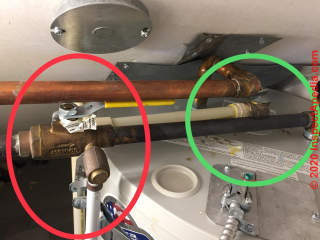 Karla
Karla
You've got it right; the green-cirvcled valve is a temperature/pressure relief valve (that you say is not leaking)
and
the red-circled valve is a combination of cold water inlet shut-off valve and a drain intended to provide relief against excessive pressure in the water heater due to thermal expansion - as discussed on this page.
Similar products manufactured by Watts are described at
WATER HEATER THERMAL EXPANSION PRODUCTS - WATTS [PDF]
I'd like to see the tag details or get the brand of your particular valve since I'm not sure it's one of the Watts products.
Yours might be a Conbraco or Webstone product.
See also these WATER HEATER VALVES - CONBRACO [PDF]
Other manufacturers:
B&G - Bell & Gossett
Jomar
The valve could be leaking from over-pressure, water hammer, or other causes listed above on this page.
On 2020-10-02 - by (mod) -
Karla
You've got it right; the green-cirvcled valve is a temperature/pressure relief valve (that you say is not leaking)
and
the red-circled valve is a combination of cold water inlet shut-off valve and a drain intended to provide relief against excessive pressure in the water heater due to thermal expansion - as discussed on this page.
Similar products manufactured by Watts are described at WATER HEATER THERMAL EXPANSION PRODUCTS - WATTS [PDF] https://inspectapedia.com/plumbing/Watts-Thermal-Expansion-Products.pdf
On 2020-10-02 by Karla
Here is a closer image of the P/T valve on the water heater. (it does look somewhat corroded)
[Shown at the start of this discussion ] is an image of the set up. The water is coming from the valve/tube circled in red.
On 2020-10-02 by danjoefriedman (mod) - leaks at the thermal expansion control valve on a water heater
Karla
Can you use the "add image" button to post a photo?
I want to be sure we are not seeing water dripping out of an ordinary Pressure/Temperature relief valve as that can be dangerous.
On 2020-10-02 by Karla
My hot water tank has a Thermal Expansion Control Valve installed on the cold water intake line (rather than an expansion tank). In the past 2-3 days, I have noticed that there is a small amount of water constantly draining out of this Valve/Tube.
The leakage is constant, even during/after a long hot shower, which presumably would drain a lot of the hot water out of the tank and temporarily stop any thermal expansion/condensation. It is important to note that the T&P valve on the water heater itself is fine, there is no leak or release of pressure/water happening there.
My gut instinct is that the Thermal Expansion Control Valve is simply faulty and stuck open in some way.
(Why else would it still leak when the hot water tank is being drained and cold water is entering the tank?). Wondering if anyone has any thoughts on this? I'm pretty sure I should be calling in for a repair, but unsure how urgent. (Am I at risk of a BLEVE explosion given the leak is constant, even when the tank should not be up to temp/pressure and even the pipe between the tank and the valve feels cold?).
Thanks!
On 2020-01-06 - by (mod) -
Stephanie
A typical pressure/temperature relief valve used on a residential water heater will meet these specifications:
Temperature Relief: 210°F (99°C)
Pressure Relief Range: 75 to 150 psi (5.2 to 10.3 bar).
It is possible on SOME water heaters to set the temperature above 210°F (99°C) but in my experience that would be unusual - you'd have probably scalded everyone using the hot water system.
As I advised another reader below,
A good place to start is with the diagnostics at RELIEF VALVE LEAK CAUSES inspectapedia.com/plumbing/TP_Valve_Leaks.php
where you'll find a list of common reasons that the valve might be leaking.
Watch out: a leaky TPR valve is unsafe.
1. It is already telling us that (usually) there is an unsafe condition such as pressure too high (water tank can blow up in a BLEVE explosion) or temperature too high (someone can be scalded - burned)
2. If it's dripping just because the valve itself is old and defective the risk is that scale clogs the valve, it stops relieving, and then you're missing a critical life-safety device.
On 2020-01-06 by Stephanie
If your water heater is set at very hot could that cause the pressure relief valve to blow.
On 2018-02-27 - by (mod) -
Wall
A good place to start is with the diagnostics at RELIEF VALVE LEAK CAUSES https://inspectapedia.com/plumbing/TP_Valve_Leaks.php#TP_Leak_Causes
On 2018-02-27 by wall
the hot water heater has been shut down about one year , I lit the polite then went back a few hours later when I noticed the pressure relieve valve was spraying water out. so I shut the gas off. not sure what's going on. ?
...
Continue reading at HOT WATER EXPANSION TANKS for a solution to thermal expansion leaks at relief valves on water heaters, or select a topic from the closely-related articles below, or see the complete ARTICLE INDEX.
Or see these
Recommended Articles
- EXPANSION TANK WATERLOGGED, RELIEF VALVE LEAKS
- HOT WATER PRESSURE EXPANSION RATE - how much does water expand when you heat it?
- RELIEF VALVES - TP VALVES - topic home where we include additional relief valve information including for hydronic heating and steam heating boilers used for central heating.
- RELIEF VALVE LEAKS
- HOT WATER PRESSURE EXPANSION RATE
- HOT WATER EXPANSION TANKS
- THERMAL EXPANSION of HOT WATER for an explanation of the amount by which water expands when heated
Suggested citation for this web page
THERMAL EXPANSION TPR VALVE LEAKS at InspectApedia.com - online encyclopedia of building & environmental inspection, testing, diagnosis, repair, & problem prevention advice.
Or see this
INDEX to RELATED ARTICLES: ARTICLE INDEX to T&P RELIEF VALVES
Or use the SEARCH BOX found below to Ask a Question or Search InspectApedia
Or see
INDEX to RELATED ARTICLES: ARTICLE INDEX to PLUMBING SYSTEMS
Or use the SEARCH BOX found below to Ask a Question or Search InspectApedia
Ask a Question or Search InspectApedia
Try the search box just below, or if you prefer, post a question or comment in the Comments box below and we will respond promptly.
Search the InspectApedia website
Note: appearance of your Comment below may be delayed: if your comment contains an image, photograph, web link, or text that looks to the software as if it might be a web link, your posting will appear after it has been approved by a moderator. Apologies for the delay.
Only one image can be added per comment but you can post as many comments, and therefore images, as you like.
You will not receive a notification when a response to your question has been posted.
Please bookmark this page to make it easy for you to check back for our response.
Our Comment Box is provided by Countable Web Productions countable.ca
Citations & References
In addition to any citations in the article above, a full list is available on request.
- "T&P and ASME Safety Relief Valves", (2011), retreived 10 Dec 2012, original source: http://media.wattswater.com/PG-TP-ASME.pdf,
Watts Water Technologies, No. Andover MA, USA, 978-688-1811, Website: www.watts.com,
Watts Water Technologies, Burlington ON, Canada, Tel: 905-332-7068, Website: www.wattscanada.ca - [1] "Residential Electric Water Heater Installation Instructions and Use & Care Guide", American Water Heater Co., October 2001, American Water Heater Co., Johnson City, TN, [manufacturer of residential & commercial water heaters, also manufacturer of Polaris/Commercial water heaters], Tel: 800-999-9515, web search 1/12/2012, original source: americanwaterheater.com/support/manuals/res-elect.pdf [copy on file] [Technical review requested 1/25/2011]
- [3] Pounds of lime deposited vs. temperature and hot water usage: see Purdue Bulletin #74 (also provided by A.O. Smith in the article below). Purdue's chart shows the number of pounds of lime deposited per year as a function of the water usage in gallons per day, with an assumed 10 grains of water hardness.
- [4] "When, Why, and How to Remove Water Scale from Tank Type Glass-Lined Water Heaters (for non glass-lined tanks, consult water heater manufacturer)" PDF provided by A.O. Smith Water Products Company - hotwater.com/lit/training/4800r9.pdf 800-433-2545 - 01/07/2009.
- [5] A.O. Smith's Form No. 4800 Rev. 8 Why? When? & How? /UN•LIME Specific De liming Instructions for use with Up-N-Down Transfer Kit for Tank Type Heaters. (Normally supplied in UN-LIME shipping cartons), Supersedes Form Nos. 4800 Rev. 7 and 4813-100.
- [6] A.O. Smith's Form No. 4778* All about Deliming Coil-Type/Tube-Type Commercial Water Heaters and Hydronic Boilers *Normally supplied when ordering Part No. 4930 Motorized Deliming Pump Kit
- [7] "Building Owner Water Heater Safety Notice", Building Department, City of Colleyville TX, web search 09/24/2010, original source: http://www.colleyville.com/dmdocuments/Building%20
Owner%20Water%20Heater%20Safety%20Notice%203-6-102.pdf
Quoting:
Water heater safety is imperative to the occupants of a building or structure. If improperly installed, water heaters can be detrimental to the structure, as well as being potentially fatal to its occupants. The proper installation of a water heater is so important that according to Texas State Law all water heater installations must be inspected by a state licensed plumbing inspector. - In addition to citations & references found in this article, see the research citations given at the end of the related articles found at our suggested
CONTINUE READING or RECOMMENDED ARTICLES.
- Carson, Dunlop & Associates Ltd., 120 Carlton Street Suite 407, Toronto ON M5A 4K2. Tel: (416) 964-9415 1-800-268-7070 Email: info@carsondunlop.com. Alan Carson is a past president of ASHI, the American Society of Home Inspectors.
Thanks to Alan Carson and Bob Dunlop, for permission for InspectAPedia to use text excerpts from The HOME REFERENCE BOOK - the Encyclopedia of Homes and to use illustrations from The ILLUSTRATED HOME .
Carson Dunlop Associates provides extensive home inspection education and report writing material. In gratitude we provide links to tsome Carson Dunlop Associates products and services.


